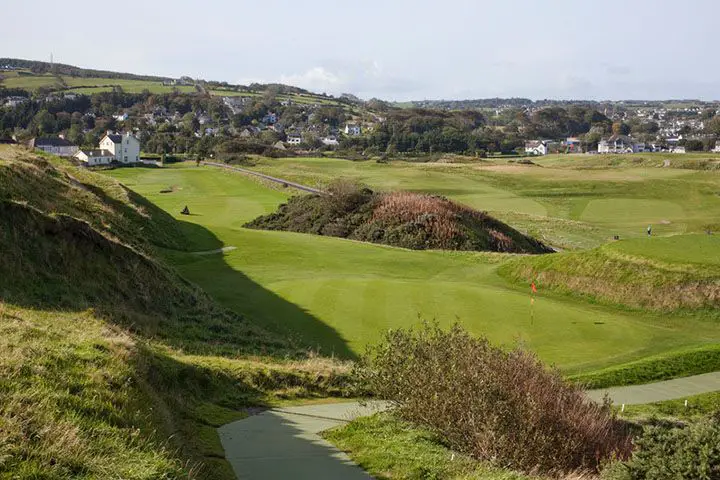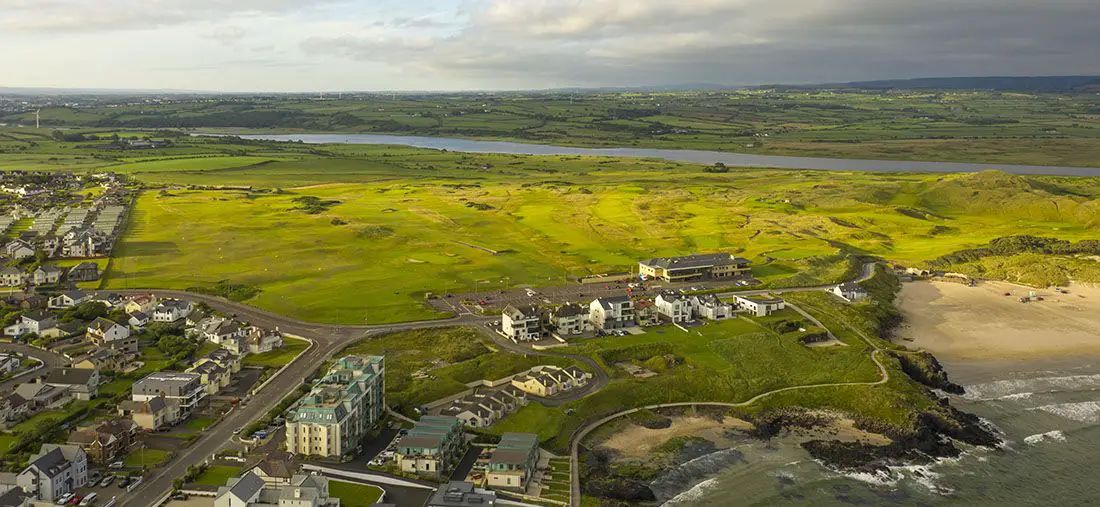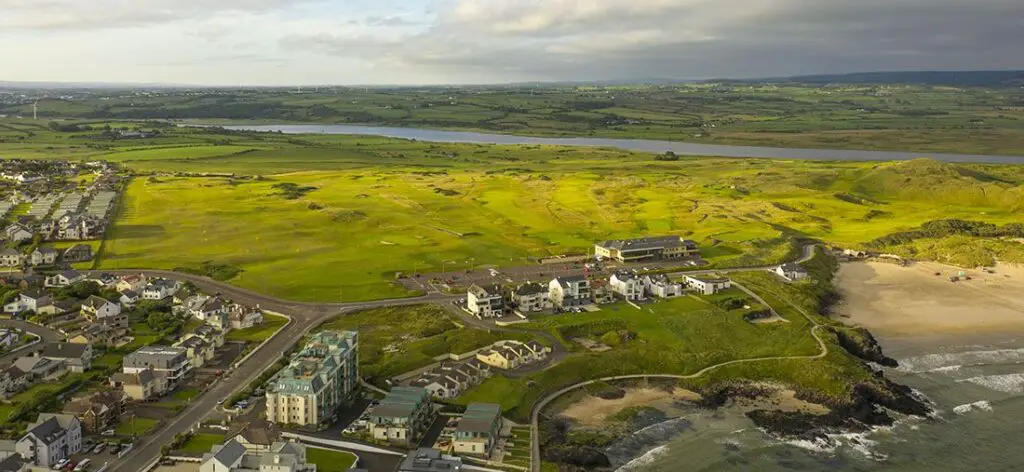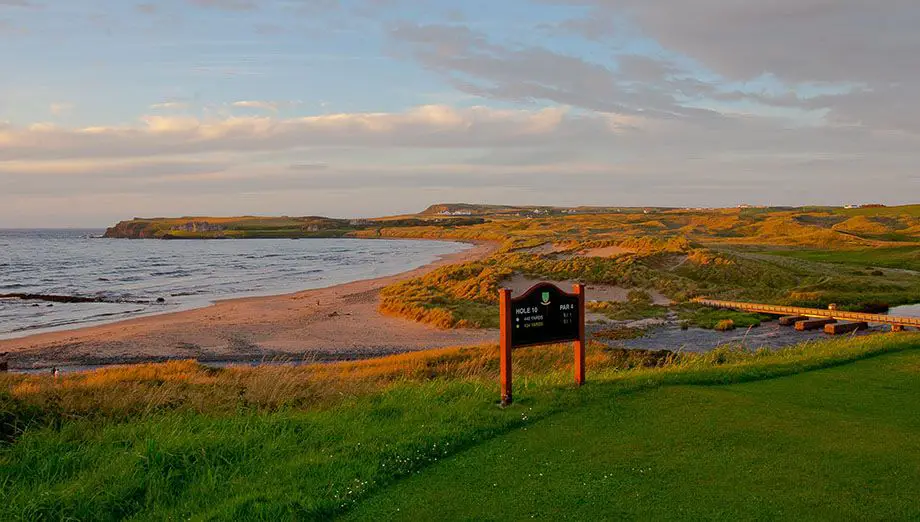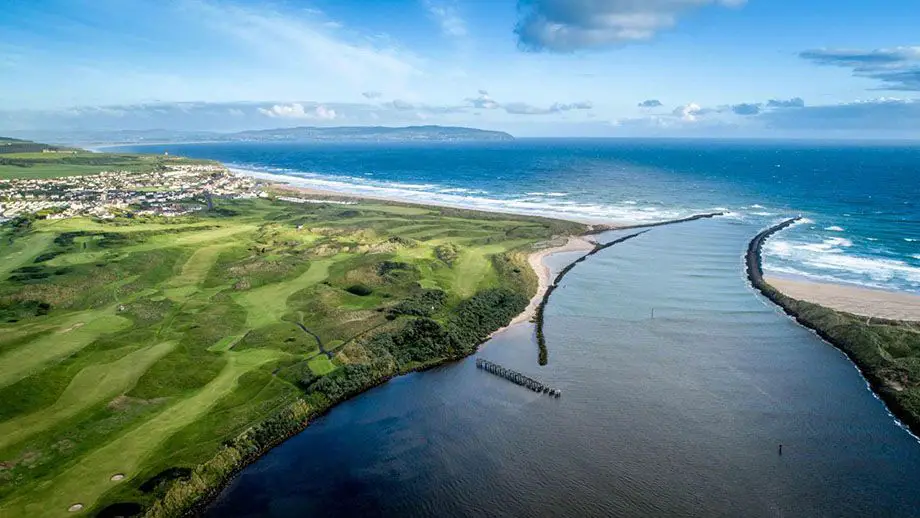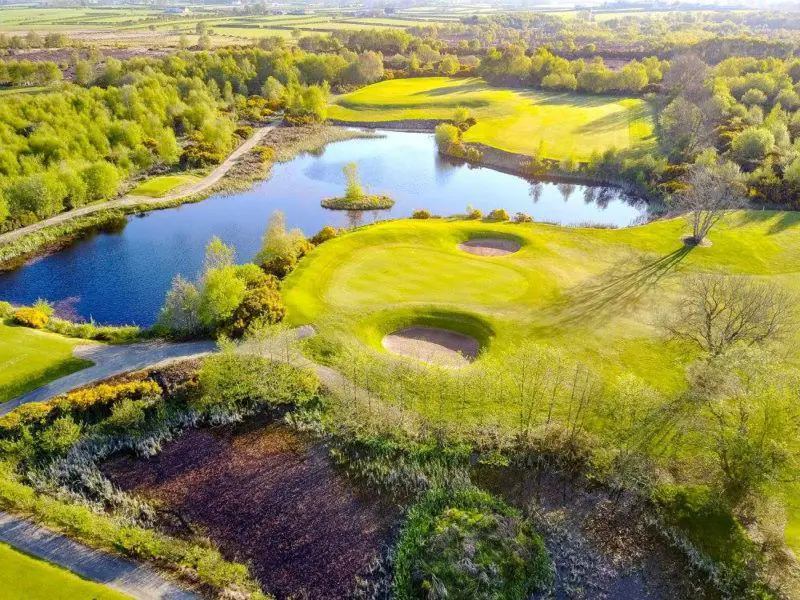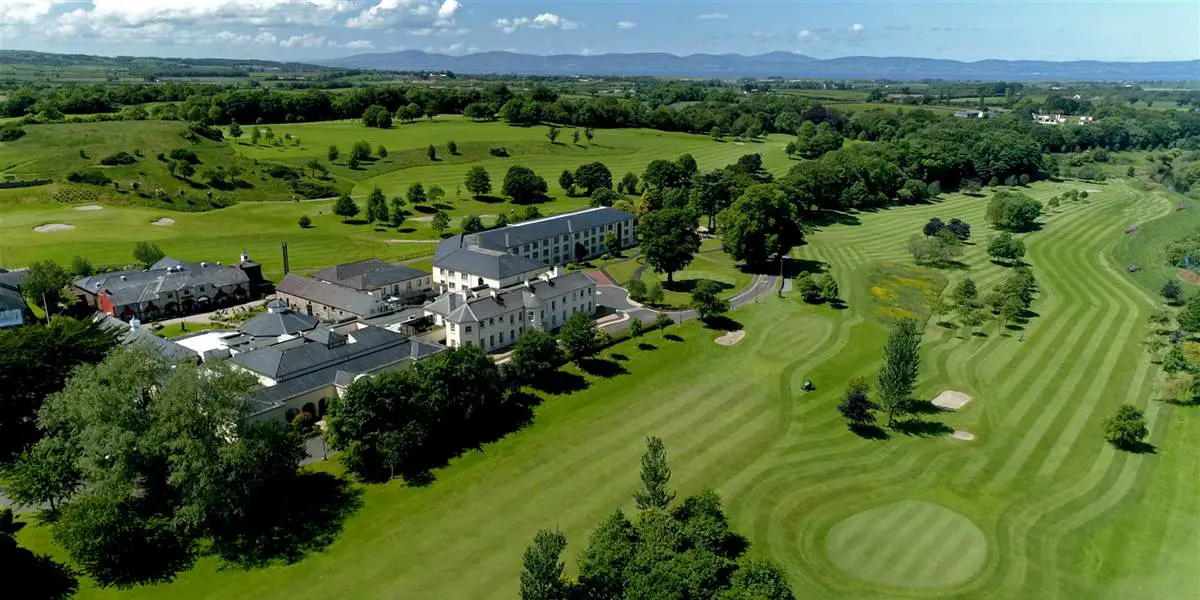Guide to Royal Portrush Golf Club
Table of Contents
The classic, sandy links of Royal Portrush are widely considered to be a mere step or two from being the finest in the world. Amateurs and professionals alike admire the fast, challenging play offered by the uniquely wrinkled and cratered greens.
Two championship courses, the Dunluce and the Valley flow along the cliff tops where there are spectacular views of County Antrim’s coastal scenery. The distinct characteristics of each course perfectly complement the other presenting thrilling challenges to all who venture to play them.
Royal Portrush is steeped in tradition and in 2019 had the honour of hosting the Open Championship for the second time in its history. Many famous names have played at Royal Portrush including Jack Nicklaus, Arnold Palmer and Ernie Els.
Royal Portrush is now the home course of Darren Clarke, the Royal St.George’s Open Champion of 2011.
The Original Links

Royal Portrush was established in May 1888 under the name of the County Club. Within a year the nine holes of the original course had doubled to eighteen and were situated on land that lies just to the south-west of the current links.
By 1890, the strong potential of the course was evident, and the club was prompted to invite the legendary St. Andrew’s golfer, Old Tom Morris, to restructure the layout.
Although Old Tom, a four-time Open Championship winner, was then aged sixty-nine, his smart design and innovative approach to maintaining the greens was to set the club on its path to success.
Just two years later in 1892, Royal Portrush hosted its first prestigious tournament, the Irish Open Amateur Championship. The event drew the attention of the Duke of York, and the course duly became known as the Royal County Club.
By 1895 the patronage of the Prince of Wales, the future King Edward VII, had been secured and the links were renamed in his honour as the Royal Portrush Golf Club.

The Course Redesign of 1929

The Irish Open Championship was launched in 1927 and was scheduled to be played at Royal Portrush in 1930. Eager to provide a tough challenge, the club embarked on an ambitious project to completely redesign the links.
The famous golf course architect, Harry S. Colt, was commissioned to create two new links, the Dunluce and the Valley. Colt was primarily known for designing inland courses around the world, but his coastal links at Portrush proved to be a resounding success.
The 1930 Irish Open was won by thirty-five-year-old Charles Whitcombe, one of three brothers who dominated golf during the nineteen-thirties.
Royal Portrush became the host of three more Irish Open Championships in 1937, 1947 and 2012. The club has regularly staged a variety of prestigious tournaments including Amateur Championships and the Senior British Open from 1995 to 1999 and again in 2004.
However, the ultimate accolade for the club was its hosting of the Open Championship in 1951, a feat which wouldn’t be repeated until 2019.
Changes to the Course for 2019

Royal Portrush was determined to have the links performing at their finest for the 148th Open Championship in 2019 and enlisted Martin Ebert to conduct some alterations.
Ebert was aware of the difficulty of improving yet preserving Colt’s famous links but was encouraged by the 1946 adjustments that had been made by club regulars, Sir Anthony Babington and P.G. Stevenson.
It was decided that the 17th and 18th holes, the Glenarm and the Greenaway respectively, didn’t do justice to the Dunluce course. The Valley links provided extra land to create two new holes which were then allotted the numbers of seven and eight.
The rest of Colt’s original hole layout from seven to sixteen was then adjusted to create a more challenging finish from nine to eighteen. Three new bunkers were included making a new total of sixty-two.
A further 200 yards (180m) was added to the course to create a maximum length of 7,337 yards (6709m) reducing the total par by one to 72.
Ebert also improved Colt’s original Valley course with the addition of new holes at the fifteenth, seventeenth and eighteenth greens.
A Tale of Two Open Championships
The Open Champion of 1951 was thirty-five-year-old Max Faulkner of England who beat his Argentinian opponent, Antonio Cerda, by two strokes.
Max, the son of a professional golfer, kept the Portrush crowds entertained with his sparkling wit which included signing autographs as ‘The Champion’ before the game had even reached its closing stages. He also demonstrated an adept use of his customised golf clubs. The Open Championship was to be Max’s only major title.

The Open Championship of 2019 was a record-breaking event in more ways than one. Northern Ireland’s trio of Rory McIlroy, Darren Clarke and Graeme McDowell were each playing in their first major event on home turf. Rory McIlroy was also the holder of the Royal Portrush club record of 61, a feat he achieved in 2005 at the age of just sixteen.
The redesigned layout ensured the Open Championship was a thrilling success attended by nearly a quarter of a million spectators over the week, the most massive crowd ever to visit the course and second only to the crowd of 2000 at St Andrew’s.
The eventual winner of the Claret Jug trophy was thirty-two-year-old Irish golfer, Shane Lowry, who beat England’s Tommy Fleetwood by six strokes. Lowry also became the new club record holder with a score of 63.
The Dunluce Links in Detail

The most distinctive feature of the Dunluce links in their natural authenticity. The fairways and greens sit so perfectly amongst the mounds and craters of the dunes that it can often be difficult at first glance to realise exactly where they are.
And when the sun’s low on the horizon seeing the contrast between the long shadows and hollows is a magical experience. Even the bunkers have been created from enhanced natural recesses.
Old Tom Morris was one of the first to suggest they should sit deep to prevent the sand from blowing away in the Atlantic storms.
Total Length: 7,337 yards (6,709 metres)
Total Par: 71
- Hughie’s – 416 yards 4 par ((Add stroke index to each hole))
You can enjoy a stern test from the first tee as the fairway leads to several mounds and hollows.
2. Giant’s Grave – 572 yards 5 par
Shots need to be precise to avoid the trio of sand-filled bunkers strewn across the fairway.
3. Islay – 174 yards 3 par
An awkward lofty position where strong prevailing winds can blow a ball straight into the rough.
4. Fred Daly’s – 479 yards 4 par
The fairway is littered with difficulties including bunkers, sandhills and unusually thick patches of rough.
5. White Rocks – 382 yards 4 par
A short start ending in an abrupt descent to the shore often causes golfers to miss the sharp right turn in the fairway.
6. Harry Colt’s – 189 yards 3 par
An elevated windy spot combines elements of rough and dunes with distracting but magnificent views of the sea.
7. Curran Point – 590 yards 5 par
One of Martin Ebert’s 2019 holes is exposed to the wind and a menacing patch of rough on the right.
8. Dunluce – 430 yards 4 par
This second 2019 addition has an elegant set of challenging bunkers and a magnificent view of Dunluce Castle.
9. Tavern – 431 yards 4 par
This stringent test combines an uphill fairway with a sharp left turn and strategically placed bunkers.
10. Himalayas – 456 yards 4 par
One glance at the series of mountainous obstacles explains its name, and there’s also treacherous rough on the right.
11. P.G. Stevenson – 475 yards 4 par
You’ll need to play your sharpest shots as prickly gorse bushes begin to take over halfway down the fairway.
12. Dhu Varren – 530 yards 5 par
This steep, sloping fairway has a stream and tangled rough lurking along its length.
13. Feather Bed – 191 yards 3 par
The hole’s name gives little warning of the hazardous stretch of five bunkers that are waiting along the short fairway.
14. Causeway – 470 yards 4 par
There’s trouble looming as gently sloping hollows along the fairway can trick a ball into the deepest of bunkers
15. Skerries – 418 yards 4 par
A steep uphill climb with an awkward turn in the fairway overlooks the Skerries, a set of sharp rocks in the Atlantic.
16. Calamity Corner – 263 yards 3 par
A thrilling uphill challenge where shots have to play across a chasm only to land amongst a set of mounds.
17. Purgatory – 405 yards 4 par
This stringent test includes an abrupt drop in the fairway that’s littered with prickly gorse and a strategic bunker.
18. Babington’s – 474 yards 4 par
There’s a dramatic finish in-store with a fairway that not only slopes downwards but has a sharp right turn halfway through.
The Valley Links in Detail

Although the prestigious Dunluce course usually receives the most attention, the Valley links are still worthy of praise.
As the base of Portrush’s Rathmore Golf Club, the Valley is a little less arduous than the Dunluce. Still, it’s by no means an inferior course mainly when past and present members include such champions as Fred Daly and Graeme McDowell.
The Valley lies in terrain that’s slightly lower than the Dunluce and is sheltered by a curtain of dunes on its coastal edge. The fairways are gentler, but they capture the atmosphere of the heathland courses that Harry Colt often designed.
And once played on, the links often work their charm to become a favourite venue. The Valley’s different to the Dunluce but it still presents an exciting challenge especially since the 2019 alterations have created stronger tests at the fifteenth, seventeenth and eighteenth holes.
Total Length: 6,346 yards (5,803 metres)
Total Par: 71
- Zara Bolton’s – 439 yards 4 par
From the tee, there is a wide fairway that quickly narrows as it leads down to a tangled patch of rough.
- Green Lane – 385 yards 4 par
The fairway has a steep descent that suddenly goes on a curve to the left-hand side and is lined with prickly gorse.
- Fairy Ring – 141 yards 3 par
You’ll enjoy trying to get through the barricade of spiky gorse and rough that lies across the approach to the green.
- War Hollow – 534 yards 5 par
A narrow fairway rolls down to an awkward ravine that blocks your path before presenting an uphill task.
- Prospect – 443 yards 4 par
From a high position at the tee, there is a sudden drop amongst the dunes as you head towards the green.
- Patrick’s – 409 yards 4 par
A long fairway to test your skills as you try to avoid the high mounds on one side and sloping rough on the other.
- Cradle – 320 yards 4 par
A thrilling descent downhill that turns slightly as you start to climb uphill where there’s plenty of encroaching rough on the right.
- Switch Back – 496 yards 5 par
There’s a tricky narrowing length to negotiate as there are relatively high mounds on either side waiting to catch you out.
- Mann’s – 150 yards 3 par
From a low tee position, you’re not likely to see just how many dunes, bunkers and patches of rough lie ahead.
- Middle Green – 465 yards 4 par
The hazards continue with large hummocks along the curving fairway which leads to a green that’s crowded with rough.
- Right About – 486 yards 5 par
A gentler slope to the fairway suddenly takes a sharp turn to the right halfway down where it can be tricky to avoid hitting the wall of high dunes.
- St. Andrew’s – 421 yards 4 par
A relatively straight right-hand diagonal run leads you into a new tangle of rough, scrub and hollows.
- Recess – 165 yards 3 par
Enjoy a broad and sweeping fairway that’s all downhill before it turns sharp right through a corridor of rough.
- Giant’s Elbow – 391 yards 4 par
From the tee, it’s a narrow fairway which leads upwards before curving between dunes, hollows and rough.
- Bunker’s Hill – 171 yards 3 par
A lofty start to the fairway where there’s a giant dune covered in rough on the right before you have to veer left to the green suddenly.
- Valley – 493 yards 5 par
You’ll love the sharp downhill slope enclosed by dunes and the barrier of sand-filled bunkers blocking your path to the green.
- Saucer – 195 yards 3 par
It’s a rollercoaster of a fairway that travels downhill then turns upwards with the added hazards of rough on either side.
- Home – 333 yards 4 par
If you can get past the mounds of rough that are lying in wait, there’s an excellent finish along bumpy terrain to look forward to.
Ladies Of Portrush

For centuries golf has been a favourite pastime for ladies with players such as Mary Queen of Scots (1542-1587) being one of its early devotees.
In 1895 Royal Portrush hosted the British Ladies Championship which had been established just two years earlier. Lady Margaret Scott aged twenty-one claimed her third consecutive victory.
In 1903 the competition was back at Royal Portrush where twenty-five-year-old Rhona Adair of Cookstown, County Tyrone, claimed a victory for Ireland.

Rhona became famous for her head-to-head match of 1899 with the grandfather of the modern game Old Tom Morris who only just managed to cling to victory. Rhona was later appointed as the Ladies’ Golf Union’s President, a post she still held at her death in Portrush in 1961.
Royal Portrush has seen the Ladies Championship return to its links a further seven times, the most recent being in 2011 which was won by England’s Lauren Taylor.
Famous Portrush Players

Royal Portrush has welcomed many prominent players such as Tom Watson and Larry Mize, but Portrush itself has produced its champions.
Fred Daly was born in 1911 in Causeway Street, and a commemorative blue plaque has since marked the house. Once a caddy at the club, Fred began playing competitive golf in 1936.

Amongst his many successes, his career highlights saw him become the first player from Ireland to win the major competitions of the Irish Open in 1946 and the British Open Championship the following year. Fred passed away in Portrush in 1990.
Graeme McDowell was born in Portrush in 1979. One of his greatest achievements so far has been his victory in the US Open Championship in 2010
Where is Royal Portrush Golf Club Located?
The entrance to the golf course is on the Dunluce Road on the outskirts of Portrush. When you’re not on the links, it’s a beautiful region to explore. To the south is the glorious countryside of County Antrim, with the Giants Causeway, Bushmills Distillery and Carrick-a-rede just along the road.
The town of seaside town Portrush is only a short walk from the entrance to Royal Portrush, having a picturesque harbour with fishing boats and yachts.
The pristine sandy beaches of the Atlantic coastline includes Whiterocks, East Strand and West Stran are popular with surfers and tourists alike. Ramore Head has walking trails, picnic areas and magnificent views.
Just above the golf course on a perilous rocky outcrop jutting into the sea is the eerie but romantic ruin of Dunluce Castle which has lent its name to the famous links. The fortress was built in the thirteenth century and eventually became the home of the clan chief, Sorley Boy McDonnell after he won it in 1584 by defeating the McQuillan clan.
Around five miles to the east of Portrush are the mysterious limestone steps of the Giant’s Causeway. It can easily be reached by road or by enjoying a ride on the scenic railway that runs several times a day from nearby Bushmills.
Visit Portrush in May to catch the annual North West 200 Motorcycle Road Race or September for the local Air Show. Portrush also has a long-established funfair and a great choice of restaurants and bars.
How to Travel to Royal Portrush from Belfast
By Car
It takes approximately one hour and fifteen minutes to travel the sixty-mile journey. Drive along the M2 to Ballyclare then the A26 to Ballymoney followed by Coleraine. Travel just five miles along the A29 to reach Portrush.
By Public Transport
The journey can take around two hours by train or bus.
How to Travel to Portrush from Londonderry-Derry
By Car
The journey of thirty-seven miles along the A2 and the A37 takes less than an hour to arrive at Portrush via Coleraine.
By Public Transport
It can take up to two hours to reach Portrush.
How Much Does a Round of Golf Cost at Royal Portrush?
During the summer season from March to October a round of golf costs £240 on the famous Dunluce links and £60 on the Valley. If you have any energy left, you can enjoy a second round for £150 and £20 respectively.
The links are open throughout the winter months from November to February with a Dunluce round costing £90 and The Valley £30.
Access times to the Dunluce course vary during the week, but Saturdays are limited until after 3.00 pm due to the weekly tournament for the club’s members. If you like an early start, the Valley can usually be played before 9.00 am except on weekends when the course is accessible from 2.00 pm.
Other Costs
You can arrange to hire a set of clubs although the price may vary depending on your choice. A manual trolley can be hired for £5. Pay £20, and you can hire an electric version that comes equipped with a GPS navigational device.
Alternatively, there are caddies available at different rates. A Trainee’s fee is £35, a Senior costs £45 and an Elite caddy is £55.
It’s also traditional to give your caddy a tip at the end of his duties.
Rules and Regulations
To play at Royal Portrush, you usually need to be a member of another club which must supply you with a Letter of Introduction. Players also have to bring a Handicap Certificate with a maximum rating of eighteen for men or twenty-four for ladies.
You are not allowed to take mobile phones or tablets onto either of the courses.
Dress Code at Royal Portrush
As befits a golf club with such an illustrious pedigree, dress code is strict with an emphasis on tailored golf wear.
There is a total ban on clothing bearing slogans of any kind. Men are only allowed to wear shirts with collars and sleeves teamed with golf trousers or Bermuda shorts.
Ladies must wear demure tops, but they have a choice of collars and no sleeves or sleeves and no collars. Golf skirts, Bermuda shorts or trousers may be worn.
Appropriate golf shoes with or without spikes must be worn at all times.
If in doubt, there is a shop on site that is stocked with a selection of approved clothing and golf accessories. And to make your visit complete, a variety of refreshments are available at the clubhouse.

